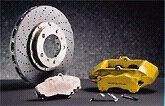For calipers, road cars today still employ single caliper per disc. Each caliper is actuated by up to 4 pistons ("4-pot") or a few racing-biased cars may even employ 6-pot calipers. The caliper is made in a single piece - so called "monobloc" - and made of aluminium. There's relatively less throughout for brake discs during the past 20-30 years. The most powerful disc brakes are still ventilated, cross-drilled and made of cast-iron, although larger wheels enable larger diameter of brake discs.
There's relatively less throughout for brake discs during the past 20-30 years. The most powerful disc brakes are still ventilated, cross-drilled and made of cast-iron, although larger wheels enable larger diameter of brake discs.
Friday, January 09, 2009
Latest Brake Development
Posted by
SANKAR
at
1/09/2009 10:48:00 AM
Labels: Recent Researches
Subscribe to:
Post Comments (Atom)
Subscribe
Search this blog
Labels
- Do You Know ? (15)
- My Own Views (10)
- Technical Videos (9)
- What's new at automotive world (9)
- Events at India (8)
- Recent Researches (7)
- Space Exploration (1)
Followers
Blog Archive
-
▼
2009
(59)
-
▼
January
(57)
- Useful Quotes - 3
- Useful Quotes - 2
- Useful Quotes - 1
- 10 fundamental differences between Linux and Windows
- 10 ways to survive office politics
- 10 Windows XP tricks and timesavers
- 10 things you should do before, during, and after ...
- Every problem has a solution if it is faced with a...
- Self Actualization is nothing but realizing the go...
- Mother - the synonym of love
- Some thing is better than having nothing to do.
- Learning will be a tougher process until we try to...
- Life is to live. It will have some up's and down's...
- Williams pulls the wraps off the FW31
- Slumdog Millionaire bangs 10 OSCAR nominations
- Chevrolet Captiva goes Automatic
- The 10 most useful Word shortcuts
- Oracle HTML DB
- Suzuki Hayabusa
- Five dumb mistakes IT pros make that can mess up t...
- Five vital communication skills for IT leaders and...
- Take control of your day with these time managemen...
- The top five reasons to check your own references
- The six types of difficult co-workers
- Four tactics for career success in 2009
- Five things we have learned from Bill Gates
- Five things that make it great to work in IT
- VOLVO B7R
- Hyundai Verna Automatic
- Mahindra Launches XYLO
- Fiat Launches the Stylish All New Linea
- Bike of the year - Yamaha FZ16
- How A Jet Engine Works
- Exactly how a car engine works - 3D animation !
- TOP 10 CONCEPT CARS 2009
- Masterful Technology
- A.R.Rehman - the international journey begins
- Slumdog Millionaire
- India - one of the best places to live
- Incredibly Incredible India
- Chak De India - title song
- Incredible India - one land everyone desire to see
- India unveils 'world's cheapest car'
- Salt Water as Fuel for cars
- Water Fuel Car
- What Will Speed Mean In Future?
- Auroras
- Bugatti Veyron Engine Components
- How a Car Engine Works
- Engine Assembly
- Piezo Electric ceramic Injector from Bosch
- New Valve Timing and Lift System "Valvematic" in T...
- Audi Introduces Compressor Supercharging
- How Light will the Cars be in future?
- Is It Possible to Assemble a Car With Glue
- Fuel Stratified Injection
- Latest Brake Development
-
▼
January
(57)


1 comments:
Nice article!
Post a Comment